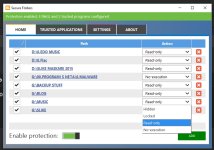- Jul 3, 2015
- 8,153
I am wondering whether Rollback Rx might actually be a convenient way to backup the C drive for recovery from a ransomware attack (and other attacks). This software stores snapshots of the C drive in a hidden partition, and even the free edition makes a new snapshot every day, when you boot. Besides that, it protects MBR from modifications.
Theoretically, ransomware could be programmed to see and encrypt all windows-compatible partitions, even hidden ones. The question is whether known types of ransomware actually do this. If they don't, then rollback seems to be a valid solution.
Please comment.
Theoretically, ransomware could be programmed to see and encrypt all windows-compatible partitions, even hidden ones. The question is whether known types of ransomware actually do this. If they don't, then rollback seems to be a valid solution.
Please comment.
